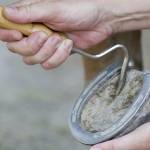Managing Horses in Mud

The freeze-thaw cycle of cold weather often creates mud. While the slippery footing rarely impacts the health of most horses, it can be a nuisance for those with certain issues.
Scratches. This skin disease affects the lower limbs and is characterized by pain, swelling, moist exudation, and hair loss. Though lesions usually form initially on the heel, they generally spread to affect the entire lower limb. As lesions multiply, exudation increases and matted hair is usually noticeable. Crusting of the wounds is common, and removal of the crusts usually elicits a pain response. In severe cases, lameness might occur. Removal of the horse from wet environments is the first step, and consultation with a veterinarian is advised.
Poor hooves. Excessive moisture over a long period might further diminish the health of compromised hooves. Because of their natural resiliency, the hooves of most horses can withstand muck without any problem, but others might not be able to handle long-term exposure. Hooves that show signs of white line disease, quarter cracks, or excessive splitting or chipping might be at risk of further damage. Pathogenic bacteria might take up residence in the soft, moist tissue and cause problems, which may ultimately lead to unsoundness.
Lost shoes. Mud can be the archenemy of certain horses, especially when it comes to thrown shoes. The suction that develops in deep mud is often strong enough to pull off shoes, especially if horses are at the end of a shoeing cycle. Although a farrier might recommended a change in shoeing to better keep shoes in place, even the most well-shod horses sometimes lose a shoe in deep mire.
Management practices should be put into place to best accommodate those horses that have adverse reactions to mud. Regular stabling on dry bedding is the most obvious way to get horses out of the mud. Other solutions are possible such as the creation of a dry pad in and around a run-in shed, using crushed gravel or other suitable footing.
Mud is inevitable. While most horses have no problem dealing with the slippery, splashy footing, others aren’t so fortunate.








